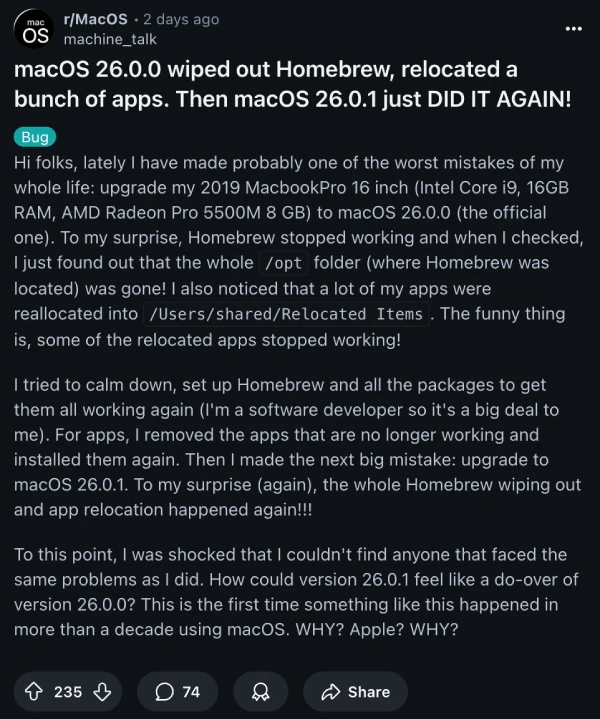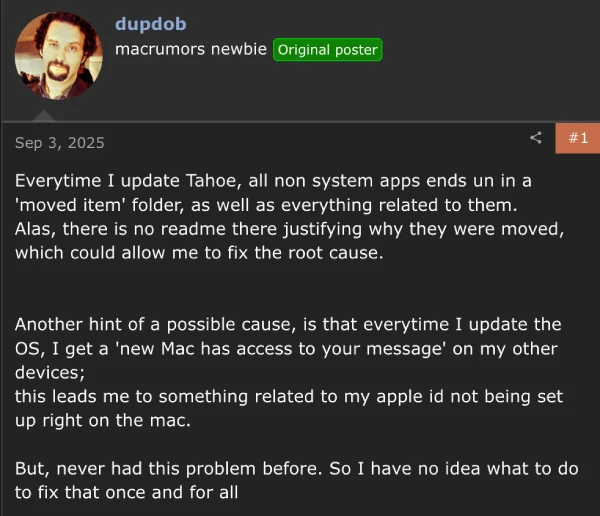Apple’s latest operating system update is causing serious problems for some Intel Mac users, with multiple reports of deleted files and mysteriously relocated applications. The issues appear to affect 2019-2020 Intel MacBook Pro models specifically
Users began noticing the problem after upgrading to macOS 26 Tahoe, and frustratingly, the issues repeated themselves when they installed the 26.0.1 update. Software developer machine_talk described the experience on Reddit as “probably one of the worst mistakes of my whole life,” after discovering that Homebrew, a popular package manager, had completely vanished from their 2019 MacBook Pro 16-inch. Even more concerning, numerous applications were forcibly moved to a folder labeled “Relocated Items” in /Users/shared/, and many of those relocated apps stopped functioning entirely.
The pattern is consistent across affected users. Each system update triggers the same file reorganization, wiping development tools and forcing users to reinstall everything. One user reported losing approximately 300GB of applications, including development tools, 3D slicers, and even some Apple apps. Touch ID settings are getting wiped as well, requiring users to re-register their fingerprints after every update. Some users have reported their Apple Pay cards disappearing entirely.
Apple Silicon Macs appear to be updating normally, with no reports of similar issues. The bug seems isolated to Intel-based machines, particularly those with T2 security chips. A MacRumors forum thread started on September 3 confirmed that multiple Intel Mac owners were experiencing identical problems, while their M-series colleagues sailed through updates without a hitch.
One user on the forums, tonton_du_plaid, tried the nuclear option: completely wiping their late 2020 MacBook Pro and performing a clean install from public beta 5. After updating to public beta 6, the exact same thing happened again. Applications downloaded directly from the Mac App Store weren’t spared either, getting moved to the mysterious “Relocated Items” folder along with everything else.
The relocated items folder doesn’t include any explanation or readme file that might help users understand why their apps were moved in the first place. This leaves affected users with no clear path to fix the underlying problem or prevent it from happening again with future updates.
Developer communities are particularly frustrated because many rely on tools like Homebrew for their daily work. Having to reinstall development environments twice in quick succession isn’t just inconvenient; it’s a productivity nightmare. Some developers mentioned keeping backup lists of their installed packages, but that doesn’t help with custom configurations or the hours lost to reinstallation.
Adding to the confusion, Homebrew itself displays a warning message stating “You are using macOS 26. We do not provide support for this pre-release version,” even though users are running the official release version of the operating system.
Apple hasn’t publicly acknowledged the issue yet, and there’s no word on when a fix might arrive. For now, Intel Mac users still running Sequoia might want to hold off on that Tahoe upgrade until Apple sorts this out. Those already affected are stuck either living with the chaos of repeated relocations or rolling back to Sequoia and hoping their backups are solid.
TechIssuesToday primarily focuses on publishing 'breaking' or 'exclusive' tech news. This means, we are usually the first news website on the whole Internet to highlight the topics we cover daily. So far, our stories have been picked up by many mainstream technology publications like The Verge, Macrumors, Forbes, etc. To know more, head here.




